 Tram Below our Window
Tram Below our Window
In Manchester, we lived in a 10th floor apartment in Salford Quay, a newly gentrified suburb which has become well-known as the center of England's broadcasting and film-making industry. We enjoyed watching the trams crisscrossing below us, especially as we rode in them several times each day. Our neighborhood with its large proportion of new buildings is similar to the city of Manchester itself, which was badly bombed during World War II but which has restored many of the elaborate Victorian buildings as well. Here is where we really began to become interested in the growth of the Industrial Revolution.
 Tram Below our Window
Tram Below our Window
Textile trade between Manchester and the United States was brisk from the 1700s on, with cotton shipped to England to be turned into thread and sent back across the sea to American textile factories, until the river traffic could no longer handle the larger ships and the resulting wear on the shoreline, not to mention the fact that Liverpool's charges for freight were considered by Manchester to be excessive. Thus the Manchester Ship Canal was built and Manchester became for awhile the third largest port in England, even though it was 40 miles inland. Built in 1893, and officially opened by the Queen in 1894, the canal was in response to the high cost of warehousing and cartage charged the Manchester cotton merchants by the Liverpool warehousemen - more per bale than the entire cost of shipping from Charleston or New Orleans to Liverpool.
 Ferry on the Ship Canal
Ferry on the Ship Canal
The Ship Canal has a lot of gee-whiz facts: we liked the fact that at least two public right-of-ways (somewhat akin to American walking trails, but imbued with the power of English law and a determined population of holiday walkers) were cut by the Canal, which duly put in place ferries (available on request) which were often mere rowboats. We also like the fact that canals can cross one another, like highways, so we had a swing bridge for a crossing canal at a higher level than ours.
The Manchester Ship Canal goes down 5 locks, about 60 feet in elevation, ending at the Mersey River in Liverpool. It brought a huge amount of new industry along its length. (The industrial revolution began here, it is generally believed, because of the availability of coal and iron and water power and water transport and ingenuity to apply steam power to the already mechanized textile mills.)
 The New Manchester Library
The New Manchester Library
Among the new civic structures, the Manchester Public Library stands out. The Manchester Central Library has only recently reopened after a multi-year closure to solve some of the problems of being a 1930s building in a 2014 world. Asbestos has been removed, windows opened to allow additional natural light, and tools like Internet and digital films and even additional electrical outlets have been added.
This is a building beloved by just about all Mancunians, judging by how many people have encouraged us to visit. So we have, spending several half-days in the local history section looking for Brian Pendleton our immigrant ancestor. On our first visit we learned that the local genealogical society had been moved into the library from separate quarters and were just getting settled. On our second visit we were offered cake and the opportunity to sing Happy Birthday with everybody in the vicinity; the library had turned eighty years old that day.
The building is definitely circular, in a dignified, vaguely Grecian way. There are no sharp corners on the outer walls. A short flight of steps leads from the sidewalk to the front door and deposits one at the edge of a central reception area, filled with large-screen computer monitors, some describing the library's services, some listing events or historic points of Manchester history and some providing access to library services such as the catalog. There's a cafe and welcoming chairs, arranged to provide peaceful reading or a chance to chat with a friend.
On the top floor, compact shelving holds the large reference collection, and there is also a beautiful reading room for serious research, plus a large music library including at least one electronic piano equipped with headphones for practice.
It all comes with a price, of course; there are murmurs that the book budget has been cut some, and desks clearly designed for several librarians are empty or staffed by just one. But this may be still part of the re-settling process. During each of our visits, the library has always been full of users and visitors. It is a pleasure to see how happy the patrons are, to have their library returned to them once again.
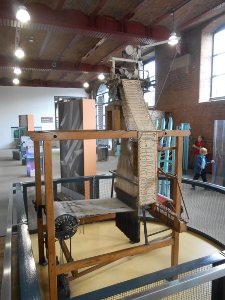 The Jacquard Loom at MOSI
The Jacquard Loom at MOSI
Manchester had a wealth of old textile mills and machinery, along with the old railroads and steam power plants. They have been turned over to MOSI, the Museum of Science and Industry, which is conserving a lot of the material for future generations. Because of the textile industry, Manchester was the original industrial heart of England; its methods were copied all over the world, and we could look at where and how it all started.
Some of the MOSI exhibits were dazzlingly beautiful; juxtaposed with the antiques were wonderful exhibits of 20th and 21st century science and technology developed in the city; one example is an exhibit of pictures from an electron microscope. On a rainy Saturday it was crowded with families, but there always seemed to be exhibits for us too. The former Manchester Air and Space museum has now been folded into one of the five big buildings, but it was the 19th century industrial revolution, explained by exhibits of the original machinery, that captured our hearts and minds.
The Power building was perhaps the most fun because buried deep in the basement was an old but still serviceable industrial-grade steam plant (which looked like a scene from a horror movie through the grating) which conveniently gave steam enough to drive all the equipment on the ground floor. Other exhibits kept us fascinated even when the science was not new. For example, we loved the old trains, of course.
Another museum emphasizing history and technology aroused emotions of a different sort: the Imperial War Museum North opened in 2002 and draws many visitors all the time. Like its parent in London, this museum is concerned with the effects of war on participants and their families .
 Alan Turing Statue
Alan Turing Statue
During the War, Alan Turing's work on deciphering the code of the Enigma Machine helped the Allies counteract the German cryptographic efforts. This brilliant man was mistreated by the British government, resulting in his death while still fairly young. Lately efforts have been made to present a most balanced view; a statue of Turing is one result. Its plaque reads: Alan Mathison Turing, 1912 - 1954 Father of Computer Science, Mathematician, Logician, Wartime Codebreaker, Victim of Prejudice. "Mathematics, rightly viewed, possesses not only truth but supreme beauty, a beauty cold and austere like that of sculpture." -- Bertrand Russell.
Stoke on Trent
Remember Spode china? Maybe your mother had a special plate which she brought out at holiday time, or maybe you received a piece or several as a wedding gift. It is china prized for the detailed pictures on each plate, from Chinese-like scenes of bridges and birds in flight to delicate multi-colored illustrations of flowers or ribbons -- and of course there is each year the Christmas plate complete with decorated Christmas tree. Those lucky enough to inherit a piece would treasure it until time to pass it to the next generation.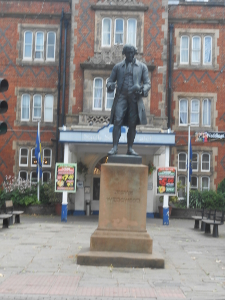 Josiah Wedgwood Statue
Josiah Wedgwood Statue
Today we hopped on the train to Stoke-on-Trent, simply because there were frequent trains and the journey was a bit over half an hour. The only thing we knew about the city was that it was in the group of pottery cities; leaving the station we were pleased to see a statue of Josiah Wedgwood.
This is another city struggling to survive the 2008 debacle. It is a work-a-day place with little of the winding streets and ancient buildings we had seen elsewhere. The site of Minton pottery is now a supermarket, the only sign of Wedgewood was the family tomb in the churchyard. The Open Market, which had been a well-known destination in Victorian days, is now the library, which has survived and thrived in its re-purposed building, having added a Citizens' Advice Bureau as a bank of staffed computer terminals.
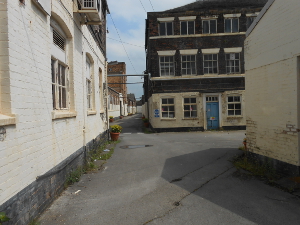 Part of the Spode Plant
Part of the Spode Plant
Wandering along the Heritage Trail, we saw a sign for the Spode Works, but the gate was closed and the display windows were empty. How sad, we said, and kept walking till we turned a corner and found the entrance to the Spode Visitor Center, where there were four friendly people who taught us much about Spode and the current situation of the factory and the city.
The beautiful decorations are applied by color transfer from engraved copper plates, sometimes quite old. Paul demonstrated the process, which involves coloring the engraved plate with a hard linseed oil paste, then passing it through a press which prints the design onto a piece of tissue paper, which is then pressed onto the china item, cleaned with saddle soap, and then removed, leaving the design transferred onto the china. After further treatment the colors keep changing until miraculously after firing the rich deep blue of Spode Willow ware comes up. A design with multiple colors is created either by pressing parts of the design several times, or by painting details with china paint. This process allows the factory to print on demand, and to easily adapt colors and designs for individual sales. Paul was aghast that the owners had still managed to let the plant go bankrupt.
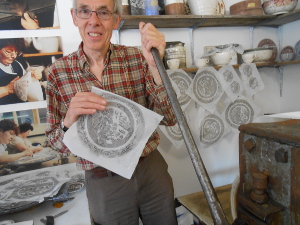 How the Designs are Made
How the Designs are Made
At the peak of their business, there were hundreds of people working in the nine-acre plant, which dates from the 18th century, and included many large kilns, storage facilities, workrooms and much more: the company saved everything, so the safe which still stores patterns and copper engraved plates is the size of a small house. By the beginning of the 21st century, they received busloads of tourists from all over the world, including many people who returned for additional purchases. At that point, the owner built an opulent art gallery and a beautifully designed and furnished room in which to display a full range of dining china.
In 2008, the company was purchased and much of the work was outsourced, an effort which turned out to be unsuccessful. The new owner had expected to use the copper plates at their facility in Malaysia but the climate was too hot and damp, so the 30,000 or so plates were returned and are now safely stored locally.
The Stoke-on-Trent City Council supports the museum as well as it can, given the constraints of money and manpower. A special Trust now controls the property, so that it will be safe no matter what. But there is not enough money to make the necessary repairs and improvements and create the kind of museum that everybody here wants to have.
Manchester
One major effect of Manchester's position as a leading industrial city was that it was a major target for German bombing in World War II. The beautiful Manchester cathedral was badly damaged by bombs in World War II, and then later by IRA bombs in 1996. Remarkably, many of Manchester's historic treasures have survived.
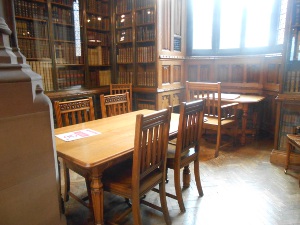 In the Rylands Library
In the Rylands Library
The Rylands Library is only a few streets away from the Cathedral. The library was a gift to the University of Manchester by a wealthy widow in honor of her late husband, and certainly deserves a place among the most beautiful libraries of the world. It is still a functioning research library; its most notable holding is a fragment of the gospel according to St. John dating from approximately 125 CE, said to be the oldest existing fragment of the New Testament.
It has comfortable reading nooks, it accepts members of the general public as readers, it still has the old card catalog (with handwritten catalog card) which is used by some readers to supplement the online catalog, it has some beautiful art, architecture, and exhibits, some of which we photographed. What caught Bob's fancy was a large oak stand with a wooden gridwork and brass labels providing numbered spaces for 152 umbrellas!
Chester
 Walking on Chester's Wall
Walking on Chester's Wall
Chester is a bit of a tourist mecca. Unlike other medieval English towns, Chester has preserved its wall so it completely circles the town.You can walk around town (we went only part way), you can see the big cathedral (very impressive outside and in, with a hidden cloister) and the lovely town hall, looking very continental. Besides that there were several quaint streets lined with half-timbered mediaeval houses and buildings. All in all a very picturesque spot, and we enjoyed ourselves greatly.
Manchester
Manchester has such a solid reputation as the City Which Began The Industrial Revolution that we have been surprised to learn its strength as a City of Libraries. In a late-Medieval building quite close to Manchester Cathedral we found a four-hundred-year-old reference library still being used by researchers and open to the public in general. We walked past rows of shelves protected by gates, and then entered the reading room, in which a sample collection from hundreds of years ago show how the precious books were chained to the shelves
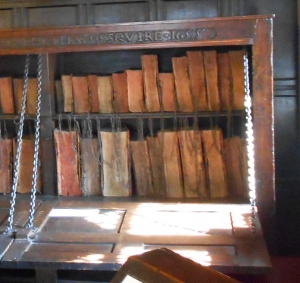 Chained in Chetham's Library
Chained in Chetham's Library
This is the library where Karl Marx and Friedrich Engels studied together, where the first head librarian, then called Warder, was John Dee (he appears as a character in period detective stories but was really a kind of wizard because of his vast knowledge).
This library is called Chetham's Library, after its founder and great benefactor, Humphrey Chetham (1580-1653), who was a kind of Andrew Carnegie of his day; he donated money for additional (chained book) libraries in cities surrounding Manchester through bequests in his will.
As we have found without fail, these amazing libraries welcoming to visitors, happy to carry on the business of conveying knowledge to anybody who seeks it -- qualities we have found in so many of the people we have met in this city.